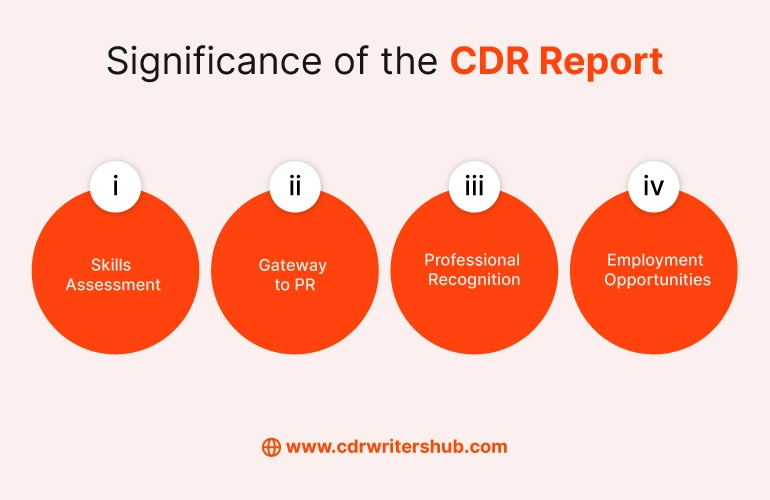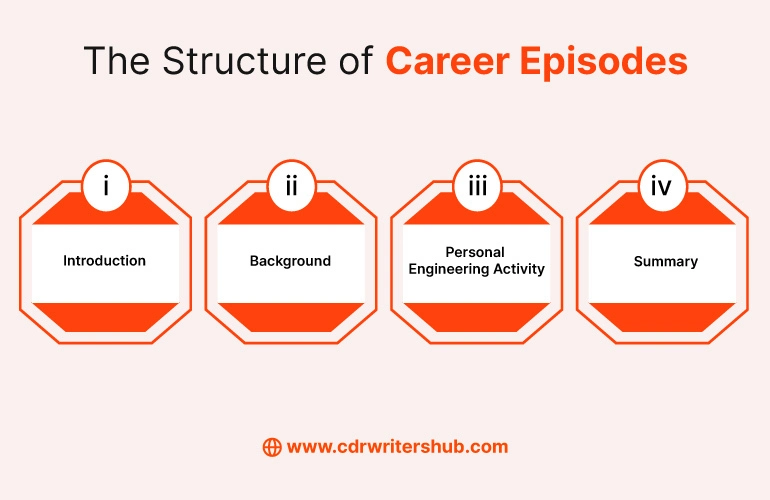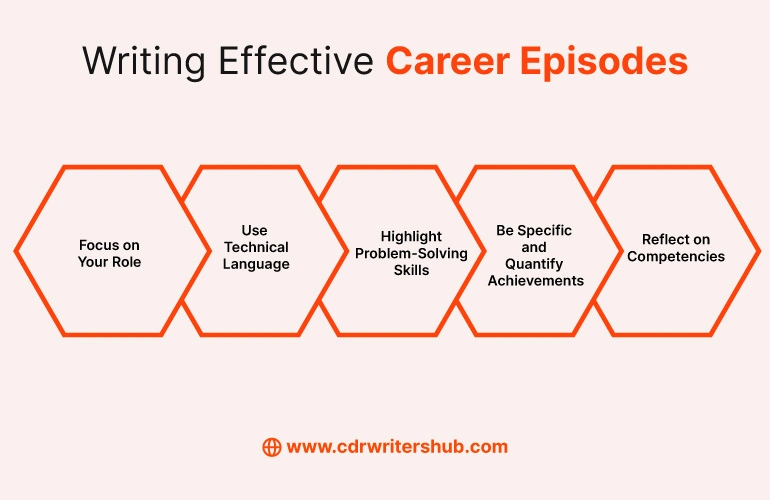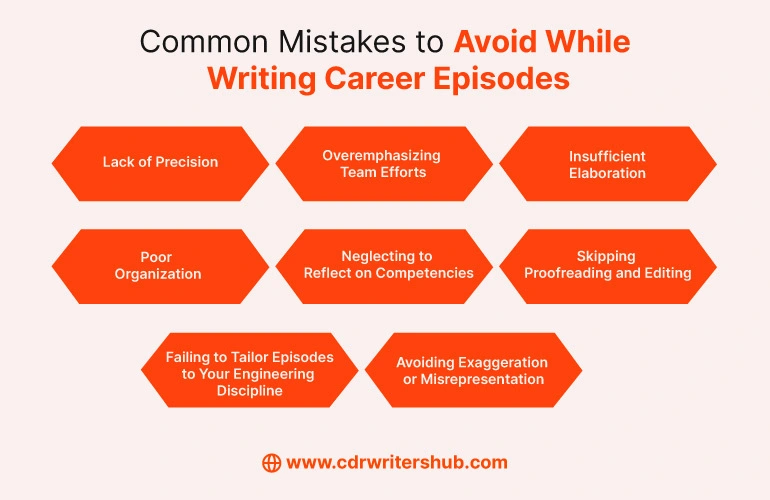The Role of Career Episodes in Your CDR Report for Australian PR

The Role of Career Episodes in Your CDR Report for Australian PR
Obtaining permanent residency (PR) in Australia as an engineer requires a detailed assessment by Engineers Australia. The Competency Demonstration Report (CDR) is a key assessment part.
Within the CDR, Career Episodes are crucial for illustrating your engineering skills and experience. This blog will explore the significance of career episodes in your CDR report for Australian PR, offering a comprehensive guide to writing compelling narratives.
Understanding the CDR Report for Australian PR
Table of Contents
The CDR report is crucial for engineers aiming for permanent residency (PR) in Australia. It serves as evidence of their engineering qualifications and competency level. It proves your engineering competencies and readiness to work in Australia. The CDR includes Continuing Professional Development (CPD), three career episodes, and a summary statement.
A significant component of the CDR report is the career episodes, which play a pivotal role in demonstrating an engineer’s skills, experiences, and adherence to the competency standards set by Engineers Australia.
Career episodes are detailed narratives focusing on specific periods or projects in an engineer’s career. These episodes provide insights into the engineer’s roles, responsibilities, achievements, and problem-solving abilities.
They serve as a bridge between the theoretical knowledge acquired through education and the practical application of that knowledge in professional settings.
What is the CDR Report, and what is its significance?
The Competency Demonstration Report (CDR) is a crucial document for engineers aiming to migrate to Australia for work opportunities. Its significance lies in its role as the primary tool for assessing the qualifications and competency levels of engineers applying for skilled migration to Australia.
In the context of applying for PR in Australia, career episodes showcase an engineer’s suitability for the Australian workforce. They provide assessors with tangible examples of the engineer’s capabilities and how they align with the standards expected by Engineers Australia.
The linkage between the CDR report and career episodes is critical for a successful PR application. Each career episode should be carefully crafted to reflect the competencies outlined in the CDR guidelines. This ensures that the engineer’s experiences are presented in a manner that meets the assessment criteria and maximizes their chances of a positive outcome.
Furthermore, the career episodes should complement other sections of the CDR report, such as Continuing Professional Development (CPD) and the Summary Statement. Together, these components create a comprehensive picture of the engineer’s qualifications, experiences, and readiness to contribute to the Australian engineering industry.
In summary, career episodes serve as the backbone of the CDR report for engineers seeking PR in Australia. They provide a platform for engineers to showcase their skills and experiences in a manner that aligns with the competency standards set by Engineers Australia, ultimately strengthening their PR application.
Understanding the CDR Report
-
Documentation of Engineering Competency
The CDR report provides a comprehensive overview of an engineer’s qualifications, skills, and experiences. It includes detailed accounts of the engineer’s education, work experience, and professional development activities.
-
Structured Format
The CDR report follows a structured format prescribed by Engineers Australia, the assessing authority. It typically consists of four main sections: continuing professional development (CPD), three career episodes, and a summary statement.
-
Career Episodes
Career episodes are detailed narratives that showcase specific engineering projects or experiences undertaken by the engineer. These episodes serve as evidence of the engineer’s competency and readiness to work in Australia.
-
Summary Statement
The Summary Statement cross-references the engineer’s experiences documented in the Career Episodes with the competency elements specified in the Australian Engineering Competency Standards (ECS). It provides a concise overview of how the engineer meets the competency requirements.
Now, let’s delve into what the CDR report entails and why it is essential.
Significance of the CDR Report

-
Skills Assessment
The CDR report serves as the basis for assessing an engineer’s qualifications and competency levels against the standards set by Engineers Australia. A positive assessment is a prerequisite for skilled migration to Australia under various visa subclasses.
-
Gateway to PR
Engineers who successfully obtain a positive skills assessment through the CDR report may be eligible to apply for permanent residency in Australia. PR status grants engineers the right to live, work, and study in Australia indefinitely.
-
Professional Recognition
A positive assessment from Engineers Australia based on the CDR report provides international recognition of an engineer’s qualifications and expertise. It validates their professional standing and enhances their credibility in the global engineering community.
-
Employment Opportunities
Engineers with a positive skills assessment through the CDR report may attract interest from Australian employers seeking skilled professionals. This opens up opportunities for employment and career advancement in Australia’s vibrant engineering industry.
In summary, the CDR report is a vital document that plays a significant role in assessing the qualifications and competency levels of engineers seeking skilled migration to Australia.
Its significance extends beyond immigration, providing international recognition, professional validation, and access to employment opportunities in Australia’s dynamic engineering sector.
What are Career Episodes?
Career Episodes are detailed accounts of your engineering experiences. Each Career Episode should focus on a specific period or aspect of your engineering career.
These episodes are vital in demonstrating how your skills and experiences meet Engineers Australia’s competency requirements.
Each career episode focuses on a distinct period or aspect of the engineer’s career and serves as a means to demonstrate their engineering competencies and professional capabilities.
In essence, Career Episodes offer a platform for engineers to showcase their skills, knowledge, problem-solving abilities, and contributions to engineering projects. They provide assessors with insight into the engineer’s practical experience and their ability to apply engineering principles in real-world situations.
Additionally, career episodes allow engineers to highlight their achievements and demonstrate how they meet the competency standards set by Engineers Australia, the assessing authority for skilled migration to Australia.
Overall, career episodes are integral components of the CDR report for migration to Australia, providing evidence of an engineer’s readiness to work in Australia as a skilled professional.
The Structure of Career Episodes

Each career episode should be written as an essay, following a structured approach to ensure clarity and coherence. Here’s a breakdown of the essential components:
1. Introduction
The introduction should be about 100 words and set the context for the Career Episode. It should include:
- The chronology
The dates and duration of the career episode.
- The location
where the experience took place.
- The organization
The name of the organization you worked for.
- Your position
Your job title during this period.
2. Background
The background section, typically around 200–500 words, provides context for the career episode. It should cover:
- The nature of the project or task
Describe what the project was about.
- The objectives of the project
Explain what the project aims to achieve.
- The organizational structure
Give an overview of the team and your place within it.
- Your specific role and responsibilities
Outline your duties and responsibilities for the project.
3. Personal Engineering Activity
This is the core of the Career Episode, spanning 500–1000 words. It should describe in detail your role in the project, focusing on:
- The technical work you performed
Explain the engineering tasks you carried out.
- The problems you encountered and how you solved them
Highlight the challenges you faced and your problem-solving approach.
- The engineering knowledge and skills you applied
Detail the technical skills and knowledge you used.
- Any innovative techniques or methodologies you employed
Mention any innovative approaches you introduced.
- Your contributions to team efforts and the leadership roles you undertook
Describe your role within the team and any leadership you provided.
4. Summary
The summary, about 50–100 words, should reflect on the career episode, highlighting:
- The overall success of the project
Summarize the outcomes and success of the project.
- Your contributions to the project’s outcomes
Emphasize your role in achieving the project’s success.
- The competencies you demonstrated were
Tie your actions to the competencies Engineers Australia is looking for.
What is the role of career episodes in your CDR for Australian PR?
Career episodes are like stories in your CDR for Australian PR. They’re detailed accounts of your experiences in engineering, showcasing your skills and achievements.
These narratives are structured to show how you tackled challenges, solved problems, and met the standards set by Engineers Australia.
Each career episode follows a format: introduction, background, personal engineering activity, and summary. In the intro, you set the scene by sharing when and where you worked and what you did. The background gives context to your story, explaining the project’s goals and your role.
The heart of the Career Episode is your personal engineering activity. Here, you dive into the technical side of things, describing the hurdles you faced, how you tackled them, and how your work made a difference. It’s important to show off your problem-solving skills, creativity, and leadership.
Throughout your story, you link your experiences to the competencies Engineers Australia expects. This connection shows how your actions match what they’re looking for in skilled engineers.
Finally, in the summary, you wrap up your story, highlighting what you achieved and how it proves you’re ready for PR in Australia.
In short, career episodes are your chance to tell a compelling tale of your engineering journey, skills, and readiness for the next step in Australia.
Writing Effective Career Episodes

To make your Career Episodes stand out, consider the following tips:
Focus on Your Role
While it’s essential to provide context, the focus should be on your contributions. Avoid writing about what the team did and concentrate on your specific actions, decisions, and thought processes.
Use Technical Language
Engineers Australia is interested in your technical capabilities. Use appropriate engineering terminology to describe your work. However, ensure the language is clear and concise, avoiding unnecessary jargon.
Highlight Problem-Solving Skills
One of the key things Engineers Australia looks for is your ability to solve engineering problems. Describe the challenges you faced, the thought process behind your solutions, and the impact of your actions.
Be Specific and Quantify Achievements
Provide concrete examples and quantify your achievements wherever possible. For instance, instead of saying, “I improved the process,” say, “I implemented a new process that reduced production time by 20%.”
Reflect on Competencies
Each Career Episode should address specific competencies outlined by Engineers Australia. Ensure you demonstrate your proficiency in areas such as problem-solving, project management, communication, and technical skills.
What Makes Career Episodes Special?
- Captivating Narratives
Each Career Episode is a narrative that transports assessors into your engineering world. You’ll walk them through your challenges, triumphs, and everything in between.
- Personal Touch
These episodes aren’t just about projects; they’re about you. You’ll share your role, the project’s objectives, and how you tackled obstacles with your unique skills and expertise.
- Engineering Marvels Unveiled
Get ready to unveil your engineering prowess. From problem-solving feats to innovative solutions, Career Episodes showcase your technical skills and contributions in full glory.
Common Mistakes to Avoid While Writing Career Episodes

Writing Career Episodes can be challenging. Here are some common mistakes to avoid:
Lack of Precision
Avoid being vague about your experiences. Provide specific details about your roles, responsibilities, and accomplishments in each Career Episode. Offering concrete examples and specifics will help evaluators better understand your capabilities.
Overemphasizing Team Efforts
While teamwork is valuable, make sure to focus on your contributions and successes in your career episodes. Don’t solely credit achievements to the team without highlighting your distinct role and impact. Your narrative should underscore your unique skills and achievements.
Insufficient Elaboration
Ensure you provide ample detail in your career episodes to address assessors’ potential questions. Thoroughly describe your projects, tasks, challenges faced, and solutions implemented. Incorporate pertinent technical details to showcase your expertise.
Poor Organization
A disorganized or disjointed narrative can confuse assessors. Ensure each episode follows a clear structure with logical transitions. Use headings and subheadings to guide the reader through your story effectively.
Neglecting to Reflect on Competencies
Your Career Episodes shouldn’t just outline your experiences; they should also demonstrate alignment with the competency standards of Engineers Australia. Instead of merely listing tasks, reflect on how your actions showcase your proficiency in relevant engineering skills.
Skipping Proofreading and Editing
Errors in grammar, spelling, or format can detract from the professionalism of your career episodes. Take time to proofread and edit your narratives thoroughly. Consider seeking feedback from colleagues or mentors to ensure clarity and coherence.
Failing to Tailor Episodes to Your Engineering Discipline
Ensure each Career Episode is pertinent to your chosen engineering field and illustrates your expertise within it. Avoid including irrelevant experiences and focus on those that align with the competency standards for your specific engineering discipline.
Avoiding Exaggeration or Misrepresentation
Maintain honesty and accuracy when describing your experiences and achievements. Exaggerating or misrepresenting your skills or contributions can damage your application’s credibility. Stick to facts and provide evidence to support your claims.
By sidestepping these common errors and crafting well-organized, detailed, and reflective career episodes, you can bolster your CDR report and improve your prospects of a favorable assessment by Engineers Australia.
Career Episode Example
To give you a clearer picture, here’s a simplified example of a Career Episode:
Introduction
In this career episode, I describe my role as a mechanical engineer at XYZ Company from January 2019 to December 2020 in Melbourne, Australia. My position was as a project engineer on the ABC Project.
Background
The ABC Project aimed to design and implement a new production line for the manufacturing of high-efficiency solar panels. The objective was to increase production capacity by 30% while reducing manufacturing costs.
XYZ Company, a leading solar panel manufacturer, undertook this project to maintain its competitive edge in the market. I was responsible for overseeing the design, procurement, and installation of the new production line.
Personal Engineering Activity
As the project engineer, I led the design phase, collaborating with cross-functional teams to develop detailed engineering drawings. I utilized CAD software to create 3D models of the production line, ensuring compliance with industry standards and safety regulations.
One of the significant challenges was integrating new machinery with the existing setup. I conducted a thorough analysis, identifying potential bottlenecks and designing solutions to streamline the workflow.
For instance, I redesigned the conveyor system to optimize material flow, reducing handling time by 15%.
I also played a pivotal role in the procurement process, evaluating suppliers and selecting high-quality, cost-effective components. My negotiation skills resulted in a 10% reduction in overall procurement costs.
During the installation phase, I supervised the assembly of the production line, ensuring all components were installed correctly and safely. I conducted rigorous testing to validate the system’s performance, identifying and resolving any issues promptly.
Summary
The ABC Project was completed successfully, resulting in a 30% increase in production capacity and a 12% reduction in manufacturing costs. My contributions were instrumental in achieving these outcomes, demonstrating my competencies in project management, problem-solving, and technical expertise.
Additional Tips and Insights
Narrate Your Story
Treat each Career Episode as a narrative with you as the central character. Begin by setting the context, introducing the challenges you encountered, describing your problem-solving journey, and concluding with the outcomes of your efforts.
This storytelling approach not only makes your episode more engaging but also helps the assessor clearly understand your contributions and competencies.
Reflect and Revise
Before finalizing your Career Episodes, take the time to reflect on your work. Revisit the projects you are writing about to ensure every detail accurately represents your experiences and contributions.
Ask someone else or professionals to review your episodes to provide feedback and identify any inconsistencies or errors.
Connect with Competencies
Engineers Australia has specific competencies they look for in the CDR. Familiarize yourself with these and ensure each career episode demonstrates how you meet these standards.
Whether showcasing your problem-solving skills, technical expertise, or project management abilities, make these connections explicit.
Use Real Examples
Incorporate real examples and anecdotes to enhance the credibility and interest of your Career Episodes. Describe actual situations you faced, how you addressed them, and the results.
This not only demonstrates your practical experience but also makes your writing more relatable and engaging.
Maintain Professionalism
While it’s important to tell your story, maintain a professional tone throughout your Career Episodes. Use formal language and avoid colloquialisms.
This professionalism reflects well on your ability to communicate effectively in a business and technical environment.
By implementing these additional tips and insights, you can further strengthen your career episodes and present a compelling case for your engineering skills and experience. Good luck with your CDR and your journey towards securing Australian PR.
Conclusion
Career episodes are a crucial part of your CDR report for Australian PR. They provide a platform to showcase your engineering skills, problem-solving abilities, and professional achievements.
By following a structured approach and focusing on your contributions, you can create compelling career episodes that enhance your chances of securing PR in Australia.
Writing effective career episodes requires careful planning, attention to detail, and a clear understanding of Engineers Australia’s requirements.
By highlighting your technical skills, problem-solving abilities, and professional achievements, you can demonstrate your competencies and increase your chances of securing Australian PR.
Remember, each career episode should be a unique narrative that reflects your engineering journey. With thorough preparation and a focus on showcasing your strengths, you can craft career episodes that stand out and make a strong case for your engineering skills and experience.
FAQs
1. What exactly is a CDR report, and why does it matter for engineers?
A CDR (Competency Demonstration Report) is an essential document needed by Engineers Australia for engineers looking to migrate to Australia. It showcases an engineer’s qualifications, skills, and experiences, serving as proof of their ability to work in Australia.
2. What do career episodes involve, and how do they contribute to the CDR report?
Career episodes are detailed stories highlighting specific engineering projects or experiences. They illustrate an engineer’s skills, problem-solving abilities, and adherence to the competency standards set by Engineers Australia.
Career episodes are pivotal in demonstrating an engineer’s suitability for migration to Australia.
3. How many career episodes are necessary for my CDR report?
Engineers are required to include three career episodes in their CDR report. Each career episode should focus on a distinct period or aspect of the engineer’s engineering career and provide evidence of their competency in their chosen field.
4. What content should I incorporate into a career episode?
Each career episode should comprise an introduction providing context, a background detailing the project or experience, a description of the engineer’s role and responsibilities, and a summary reflecting on their contributions and demonstrated competencies.
5. What factors should I consider when selecting projects for my career episodes?
Engineers should select projects or experiences that best showcase their engineering abilities and align with Engineers Australia’s competency standards. Opt for projects where you have played a significant role and can highlight a range of skills and competencies.
6. What are common errors to avoid when drafting career episodes?
Mistakes to steer clear of include being too ambiguous or generic, placing excessive emphasis on team achievements, providing insufficient detail, failing to reflect on competencies, and overlooking proofreading and editing.
7. How lengthy should each career episode be?
Career episodes typically span from 1,000 to 2,500 words each. However, emphasis should be placed on quality rather than quantity, ensuring that each episode effectively demonstrates the engineer’s skills and competencies.
8. How do career episodes aid in attaining permanent residency in Australia?
A positive evaluation of the CDR report, which includes career episodes, by Engineers Australia is a crucial step towards obtaining permanent residency in Australia. It illustrates that the engineer meets the competency standards required for skilled migration to Australia.



